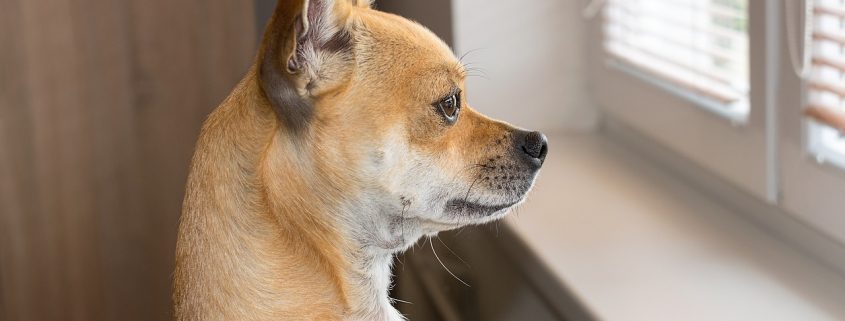Ask Crystal: Noisy Pup

Dear Crystal,
My dog Charlie barks at dogs and people especially if he is looking out the patio door. As he has gotten older he tends to handle people better when they come to the house. I don’t walk him a lot because of this. Any ideas? Charlie is Jack Russell mix and 16 lbs.
Thanks,
Noisy Pup
Dear Noisy,
Dogs bark to communicate foremost. If we think of it that way, we can try to understand what our dogs are trying to tell us. That gives us a starting point for how we can begin to work on their barking when it is bothersome. We can try to figure out how to teach our dogs better ways to communicate.
Identifying the Challenge
When we are working on a behavior problem, there are some questions we need to ask ourselves:
- When and where is the behavior happening?
- Why is it happening?
- What is the trigger for the behavior?
- What is the dog getting out of the behavior? What is reinforcing it?
When and where is the patio door when people pass by. The why could be that the dog is being territorial of his space, or he may be fearful of strangers, or he may be excited to see new people. We need more information to answer that question. What the dog is getting out of the barking is probably that the people leave. The people aren’t leaving because he is barking but the dog doesn’t know that. Behavior only continues when a dog is reinforced by it in some way. Another possibility is that he likes how it feels to bark and that also can reinforce the bark. It’s what we refer to as a self-reinforcing behavior because it intrinsically feels good to the dog.
Managing the Behavior
Management is always going to be the first step to any good behavior modification plan. How can we minimize his need to bark? The more he practices the behavior, the more wound up and reactive he gets. Ever heard of practice makes perfect? It definitely applies to dog behavior. The more a behavior is performed, the stronger the neural pathway becomes. That means it becomes more difficult to change the dog’s behavior and choose a new behavior when they have done the other behavior for so long. I like to think of it as a jungle path. When you perform a behavior, it’s like using a machete to make a trail through that path. The more you do the behavior, the smoother the path becomes. When it is time to create a new behavior choice, we have to make it more appealing to choose the less worn path.
There are a variety of options for blocking visual access to the patio window. It will depend on your home set up and budget. If your home allows for it, you may be able to put up a baby gate or puppy pen to block off access to the patio. You could drape a sheet over it so he can’t see through it. There are also removable films that you can place on windows to obscure his ability to see. You can tape poster board over the windows for an inexpensive option. If you have drapes or blinds, be sure those are shut. You probably need to play some white noise or classical music to drown out potential sounds of people if that triggers him to bark.
 It is very important that you make sure he is getting some form of exercise. I know you don’t like to walk him because of his barking. He does need some forms of exercise and enrichment. Being tired and having his needs met will very likely make him easier to train and less reactive. In my experience, JRTs love to chase things so it seems like you could play fetch or use a flirt pole. If you don’t have a fence, you can do both of those inside the house. How much exercise he needs will depends on him. I would suggest maybe starting with 2-3 15-minute play sessions and adjust to more if it doesn’t seem enough.
It is very important that you make sure he is getting some form of exercise. I know you don’t like to walk him because of his barking. He does need some forms of exercise and enrichment. Being tired and having his needs met will very likely make him easier to train and less reactive. In my experience, JRTs love to chase things so it seems like you could play fetch or use a flirt pole. If you don’t have a fence, you can do both of those inside the house. How much exercise he needs will depends on him. I would suggest maybe starting with 2-3 15-minute play sessions and adjust to more if it doesn’t seem enough.
Beyond exercise, I highly suggest looking into various forms of daily enrichment. Enrichment is an activity which is based on a dog’s natural behaviors which enhance his life. This could be scent work which are games that they use their nose to find treats or scented items. JRTs search out prey so scent work seems like something he might really like. Decompression walks which are walks on a long line in a quiet area that allow them to control the walk and sniff to their hearts content. Food enrichment is feeding through toys rather than bowls and it’s probably the easiest way to bring some additional activity in his life. Finding the right balance of exercise and enrichment will help him to become calmer. A large component of barking is over arousal so finding ways to take the edge off of his excitement is important.
Barking Specific Analysis
Based on the information you have shared, I am going to make an educated guess that his barking is alarm or alert barking. Basically, your dog letting you know someone walked by the property. He may have other types of barking episodes but those will need to be addressed individually depending on what is causing it.
Alarm barking responds pretty well to counterconditioning and desensitization. This means that we expose the dog to the trigger at a level which does not cause the barking and pair it with a reinforcer such as food. Sit with him away from the patio but to where he can still see but far enough away that he won’t bark. When he notices the person, feed him a high value treat. Let him look at it and then treat. Repeat until the person is out of view and then stop the treats. When you are not actively working on this training, he needs to be blocked from seeing out the patio.
If you can’t find a distance in the house that he won’t bark at, you may need to work on him hearing people rather than seeing at first. It would be a similar procedure, but you would treat when you can see he is hearing a person and not barking. You should be able to progress to visual exposure after a period of working on auditory exposure.
You should also work on a cue that is an interrupter. This is a cue that will stop the dog momentarily and reorient him to you so that you can redirect him. This won’t solve the problem completely like counterconditioning and desensitization, but it will help you prevent him from practicing the behavior and keep his arousal levels at a lower level.
A positive interrupter is a word or noise that you pair with a food reward. You condition the dog that the word means he gets a piece of food. When he hears the word, he will come over to you for a treat and you can redirect him until the trigger has passed.
Start in a low distraction environment when the dog is not barking. I like to use something like “uh-oh”. It’s hard to say that with too harsh of a tone. Say your interrupter and feed a treat. Do this many times over many days. What we are looking for when we condition a dog to a word is an automatic response to that word. The dog doesn’t think about whether he wants to listen or not. He just hears the word and comes over. Practice in the house when the dog is mildly interested in something else. Then work up to interrupting sniffing outside or other distractors. Once he can automatically come back from those distractions, you can begin training when he starts barking. Say “uh-oh” and when he comes over and stops barking, have him do some behaviors like sit or down to occupy him until the trigger has passed.
Training Calm Behaviors
Work on training calm behaviors in your dog. You can work on impulse control behaviors like waiting for his food and going out the door. This will help him focus when he is excited. A go to your mat or place cue is a great tool for managing a dog when someone comes to the door or other times when you need the dog to lie down and not get up. Capture moments of calm behavior that are offered by feeding treats for nice, relaxed behavior. The Relaxation Protocol by Dr. Karen Overall is a great way to teach a dog to relax through a variety of situations and to look to their handler for feedback about situations that make them feel unsure.
Dogs are going to bark. It’s totally normal behavior and it’s not going to be something that you can get rid of totally. You can, however, help your dog to be calmer and be able to focus on you when you need him to. If you work on his behavior in the home, you should be able to transfer the training while you are taking him for walks as well so you can get to where you are able to walk him again. If you don’t see improvement; consider hiring a Certified Professional Dog Trainer. Locate one here.
Until next time,
Crystal







